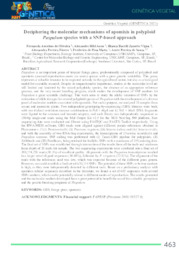Deciphering the molecular mechanisms of apomixis in polyploid Paspalum species with a SNP-based approach.
Deciphering the molecular mechanisms of apomixis in polyploid Paspalum species with a SNP-based approach.
Author(s): OLIVEIRA F. A. DE; AONO, A. H.; VIGNA, B. B. Z.; FAVERO, A. P.; MATTA, F. de P.; SOUZA, A. P. DE
Summary: Paspalum is an important genus of tropical forage grass, predominantly composed of polyploid and apomictic (asexual reproduction mode via seeds) species with a great genetic variability.
Publication year: 2021
Types of publication: Abstract in annals or event proceedings
Keywords: Apomixis, Forage grass, GBS, Paspalum
Observation
Some of Embrapa's publications are published as ePub files. To read them, use or download one of the following free software options to your computer or mobile device. Android: Google Play Books; IOS: iBooks; Windows and Linux: Calibre.
Access other publications
Access the Agricultural Research Database (BDPA) to consult Embrapa's full library collection and records.
Visit Embrapa Bookstore to purchase books and other publications sold by Embrapa.

